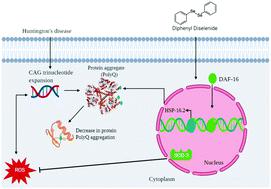当前位置:
X-MOL 学术
›
Metallomics
›
论文详情
Our official English website, www.x-mol.net, welcomes your feedback! (Note: you will need to create a separate account there.)
Diphenyl diselenide protects a Caenorhabditis elegans model for Huntington's disease by activation of the antioxidant pathway and a decrease in protein aggregation.
Metallomics ( IF 3.4 ) Pub Date : 2020-05-05 , DOI: 10.1039/d0mt00074d Fabiane Bicca Obetine Baptista 1 , Leticia Priscilla Arantes 1 , Marina Lopes Machado 1 , Aline Franzen da Silva 1 , Larissa Marafiga Cordeiro 1 , Tássia Limana da Silveira 1 , Felix Alexandre Antunes Soares 1
Metallomics ( IF 3.4 ) Pub Date : 2020-05-05 , DOI: 10.1039/d0mt00074d Fabiane Bicca Obetine Baptista 1 , Leticia Priscilla Arantes 1 , Marina Lopes Machado 1 , Aline Franzen da Silva 1 , Larissa Marafiga Cordeiro 1 , Tássia Limana da Silveira 1 , Felix Alexandre Antunes Soares 1
Affiliation

|
Huntington's disease (HD) is an autosomal dominant, progressive neurodegenerative disease with a distinct phenotype. It occurs due to a mutation in the huntingtin (or IT19) gene with an abnormal CAG repeat, leading to a variable length N-terminal polyglutamine chain (poly-Q). Like most neurodegenerative diseases, HD is characterized by the abnormal deposition and aggregation of proteins in the cell, which impairs the proteostasis and disrupts cellular homeostasis. In this study, we used Caenorhabditis elegans as an animal model due to its easy genetic manipulation and high homology of genes and signaling pathways with mammals. Worms were exposed to diphenyl diselenide (PhSe)2 at 25, 50 and 100 μM, and then we analyzed the polyQ aggregation, neurodegeneration, touch response, reactive oxygen species (ROS) levels, lifespan and health span. In addition, we analyzed the involvement of the transcription factor DAF-16, a FOXO-ortholog, and the downstream heat-shock protein-16.2 (HSP-16.2) and superoxide dismutase-3 (SOD-3). Our data demonstrate that chronic treatment with (PhSe)2 reduced polyQ aggregation in muscle and polyQ mediated neuronal cell death of sensory neurons ASH, as well as maintaining the neuronal function. In addition, (PhSe)2 decreased ROS levels and extended the lifespan and health span of wild type and PolyQ mutant worms. The mechanism proposed is the activation of DAF-16, HSP-16.2 and SOD-3 in whole body tissues to increase the antioxidant capacity and regulation of proteostasis, decreasing PolyQ aggregation and toxicity and reducing ROS levels, leading to an increase in lifespan, and healthspan. Our findings provide new clues for treatment strategies for neurodegenerative diseases and other diseases caused by age-related protein aggregation.
中文翻译:

二苯基二硒化物通过激活抗氧化途径和减少蛋白质聚集来保护秀丽隐杆线虫亨廷顿病模型。
亨廷顿病 (HD) 是一种常染色体显性遗传、进行性神经退行性疾病,具有独特的表型。它的发生是由于具有异常 CAG 重复的亨廷顿 (或 IT19) 基因突变,导致可变长度的 N 端多聚谷氨酰胺链 (poly-Q)。与大多数神经退行性疾病一样,HD 的特征是细胞内蛋白质的异常沉积和聚集,这会损害蛋白质稳态并破坏细胞稳态。在这项研究中,我们使用秀丽隐杆线虫作为动物模型,因为它易于遗传操作,并且基因和信号通路与哺乳动物具有高度同源性。蠕虫暴露于二苯二硒化物 (PhSe) 225、50 和 100 μM,然后我们分析了 polyQ 聚集、神经变性、触摸反应、活性氧 (ROS) 水平、寿命和健康跨度。此外,我们分析了转录因子 DAF-16、FOXO 直向同源物和下游热休克蛋白 16.2 (HSP-16.2) 和超氧化物歧化酶-3 (SOD-3) 的参与。我们的数据表明,用 (PhSe) 2长期治疗减少了肌肉中的 polyQ 聚集和 polyQ 介导的感觉神经元 ASH 的神经元细胞死亡,以及维持神经元功能。此外,(PhSe) 2降低 ROS 水平并延长野生型和 PolyQ 突变蠕虫的寿命和健康跨度。提出的机制是激活全身组织中的 DAF-16、HSP-16.2 和 SOD-3,以增加抗氧化能力和调节蛋白质稳态,减少 PolyQ 聚集和毒性,降低 ROS 水平,从而延长寿命,以及健康跨度。我们的研究结果为神经退行性疾病和其他由年龄相关的蛋白质聚集引起的疾病的治疗策略提供了新的线索。
更新日期:2020-05-05
中文翻译:

二苯基二硒化物通过激活抗氧化途径和减少蛋白质聚集来保护秀丽隐杆线虫亨廷顿病模型。
亨廷顿病 (HD) 是一种常染色体显性遗传、进行性神经退行性疾病,具有独特的表型。它的发生是由于具有异常 CAG 重复的亨廷顿 (或 IT19) 基因突变,导致可变长度的 N 端多聚谷氨酰胺链 (poly-Q)。与大多数神经退行性疾病一样,HD 的特征是细胞内蛋白质的异常沉积和聚集,这会损害蛋白质稳态并破坏细胞稳态。在这项研究中,我们使用秀丽隐杆线虫作为动物模型,因为它易于遗传操作,并且基因和信号通路与哺乳动物具有高度同源性。蠕虫暴露于二苯二硒化物 (PhSe) 225、50 和 100 μM,然后我们分析了 polyQ 聚集、神经变性、触摸反应、活性氧 (ROS) 水平、寿命和健康跨度。此外,我们分析了转录因子 DAF-16、FOXO 直向同源物和下游热休克蛋白 16.2 (HSP-16.2) 和超氧化物歧化酶-3 (SOD-3) 的参与。我们的数据表明,用 (PhSe) 2长期治疗减少了肌肉中的 polyQ 聚集和 polyQ 介导的感觉神经元 ASH 的神经元细胞死亡,以及维持神经元功能。此外,(PhSe) 2降低 ROS 水平并延长野生型和 PolyQ 突变蠕虫的寿命和健康跨度。提出的机制是激活全身组织中的 DAF-16、HSP-16.2 和 SOD-3,以增加抗氧化能力和调节蛋白质稳态,减少 PolyQ 聚集和毒性,降低 ROS 水平,从而延长寿命,以及健康跨度。我们的研究结果为神经退行性疾病和其他由年龄相关的蛋白质聚集引起的疾病的治疗策略提供了新的线索。



























 京公网安备 11010802027423号
京公网安备 11010802027423号